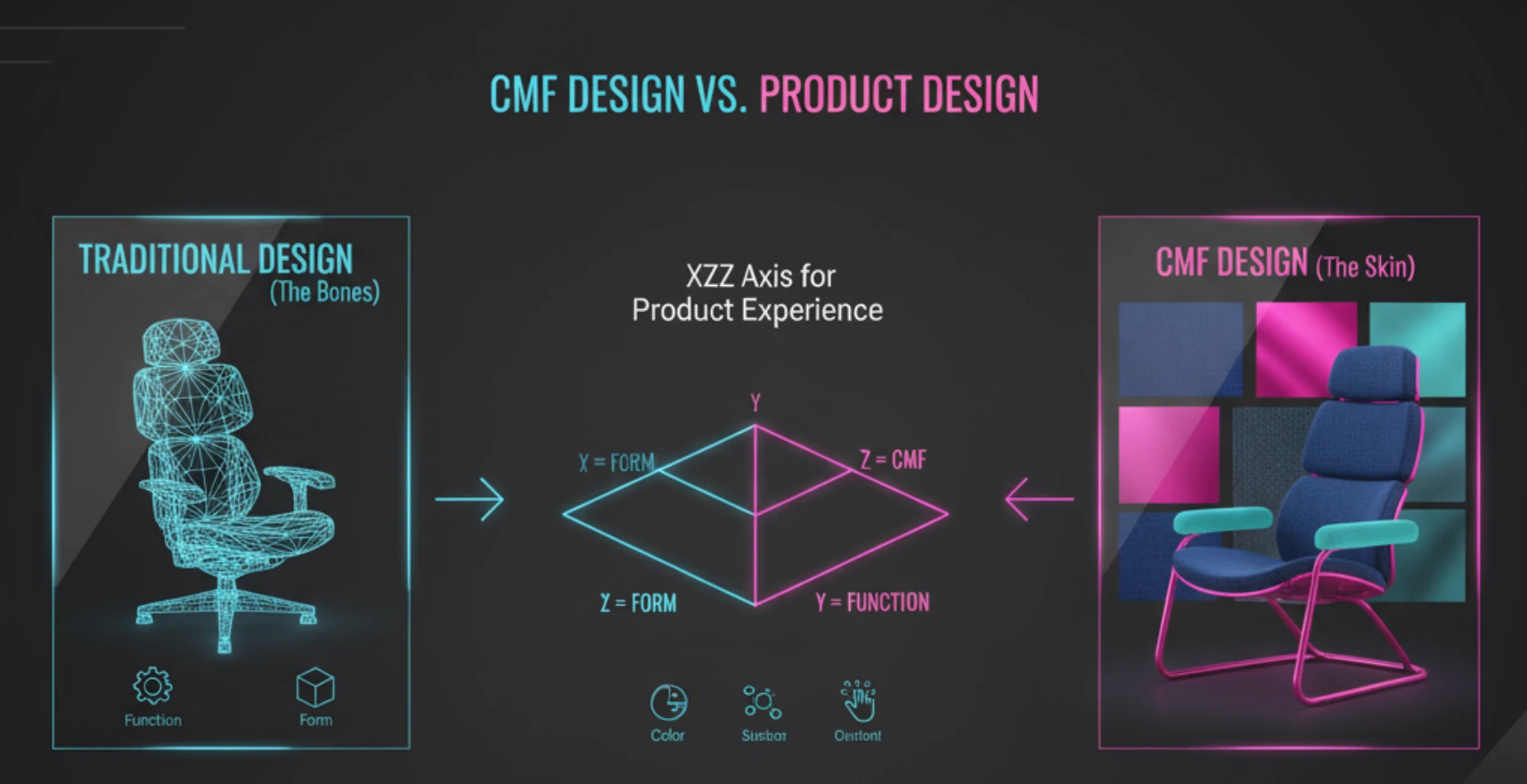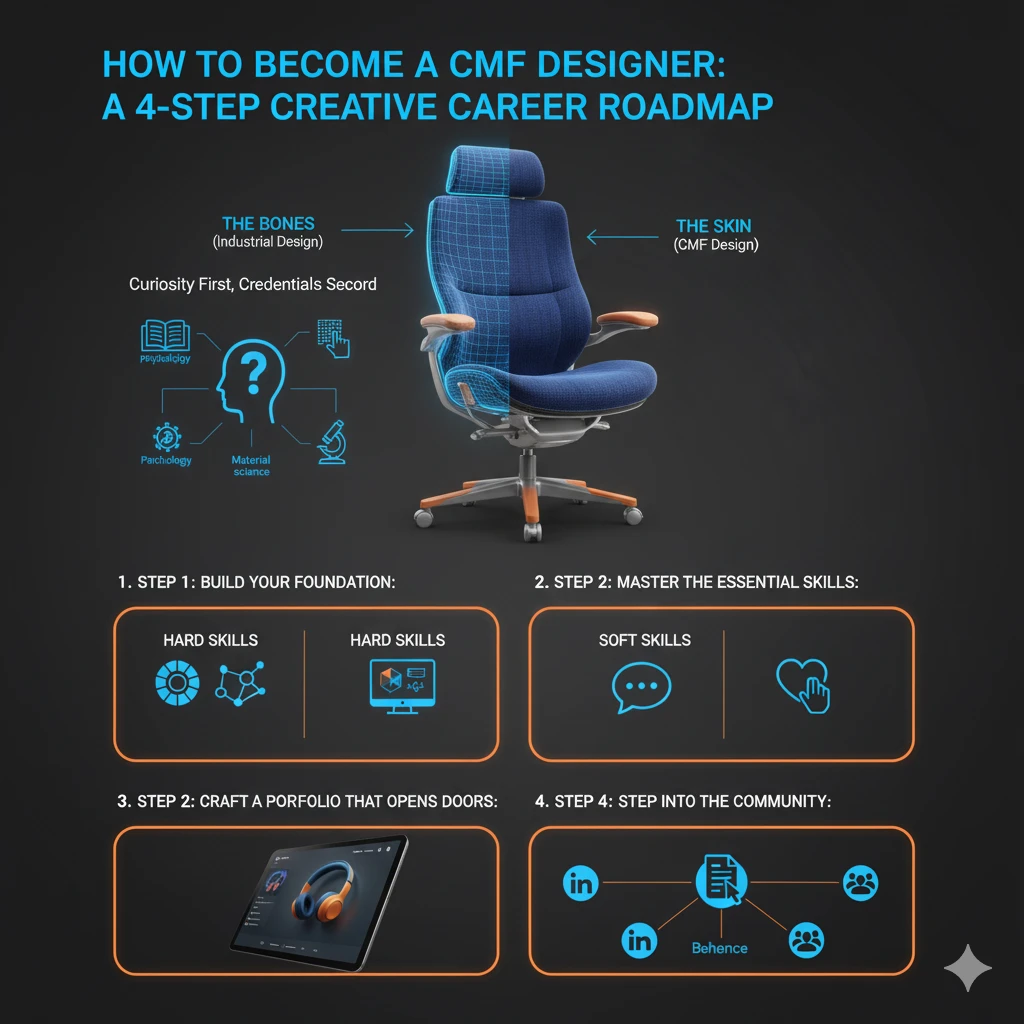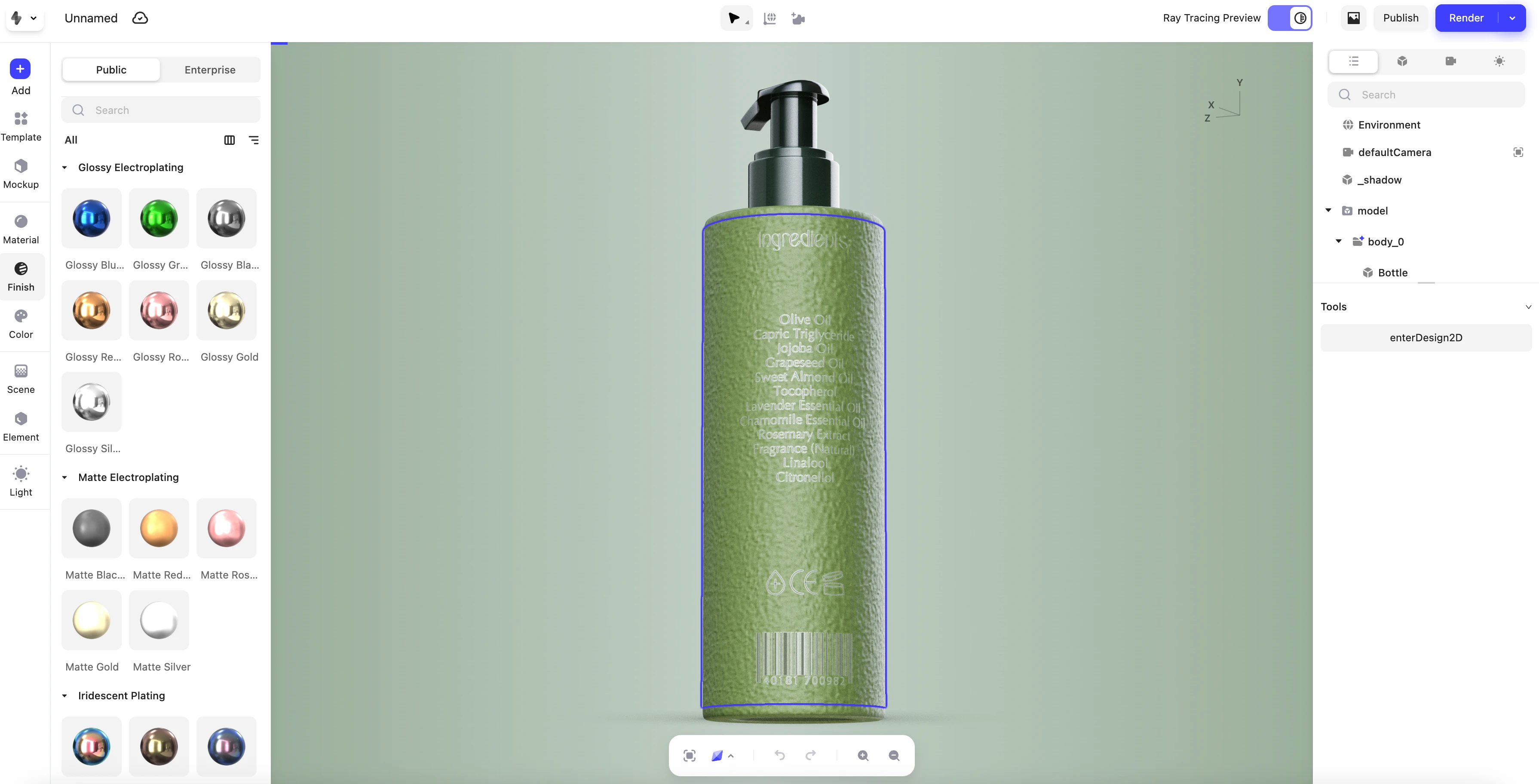I didn’t “decide” to become a designer in the neat, linear sense. It was more like a slow infection, carried by objects. A camera dial, cool to the touch, almost stubborn in its resistance; the dry, metallic clack of a shutter that seemed louder than it should; a plastic handle that always felt slightly wrong, like it was lying about its worth. Those little details lingered in my head long after the moment had passed.
I didn’t know the term yet, but I was already training the instincts of a CMF Designer.
What Does a CMF Designer Actually Do?
If you strip it down, CMF—Color, Material, and Finish—is about mood and memory disguised as surface choices. Industrial designers make the bones. CMF designers decide the skin: how it catches light, how it warms or cools to the touch, how it convinces you—before you’ve pressed a button—that this thing belongs in your life.
On any given week, a CMF designer might:
 Scan the horizon for signals: cultural tremors, micro-trends, fringe experiments that hint at tomorrow’s palette.
Scan the horizon for signals: cultural tremors, micro-trends, fringe experiments that hint at tomorrow’s palette. Hunt for new matter: sustainable composites, recycled textiles, even lab-grown leather that challenges the idea of “authentic.”
Hunt for new matter: sustainable composites, recycled textiles, even lab-grown leather that challenges the idea of “authentic.” Render the unseen: building digital twins so convincing you half expect fingerprints to smudge the screen.
Render the unseen: building digital twins so convincing you half expect fingerprints to smudge the screen. Translate vision into production: whispering across departments—engineers, marketers, manufacturers—to keep the story intact from sketch to shelf.
Translate vision into production: whispering across departments—engineers, marketers, manufacturers—to keep the story intact from sketch to shelf.
 CMF-design-infographic-2-369ljm.webp
CMF-design-infographic-2-369ljm.webp
👉 A primer worth reading: What is CMF Design?
The 4-Step Roadmap to Becoming a CMF Designer
This isn’t a sprint. It’s more like learning a dialect—absorbed slowly, practiced awkwardly, then spoken fluently. Still, the path can be sketched in four strokes.
 4 Step to become a CMF Designer
4 Step to become a CMF Designer
Step 1: Build Your Foundation (Curiosity First, Credentials Second)
There’s no magic diploma. CMF designers come from fashion studios, physics labs, design schools, or none of the above. What binds them is obsession.
Your curriculum is improvised:
 Dog-ear books on color psychology.
Dog-ear books on color psychology. Fall down rabbit holes in material science blogs.
Fall down rabbit holes in material science blogs. Get lost in a car museum just to watch the light bend on vintage paint.
Get lost in a car museum just to watch the light bend on vintage paint. Touch things you’re not supposed to in hardware stores.
Touch things you’re not supposed to in hardware stores.
It’s less about what you study and more about what you notice.
Step 2: Master the Essential Skills (Your Toolkit)
You’ll need both scalpel-sharp technical ability and softer instincts.
Hard Skills
 Forecasting: decoding cultural noise into usable design signals.
Forecasting: decoding cultural noise into usable design signals. Color Theory: not just harmony, but tension—how hues fight and flirt in three dimensions.
Color Theory: not just harmony, but tension—how hues fight and flirt in three dimensions. Material Science: enough literacy to know why one plastic sings under pressure and another cracks.
Material Science: enough literacy to know why one plastic sings under pressure and another cracks. 3D Visualization: conjuring photoreal scenes before a factory cuts a single mold.
3D Visualization: conjuring photoreal scenes before a factory cuts a single mold.
Soft Skills
 Narrative Sense: being able to justify why this matte finish tells a better story than gloss.
Narrative Sense: being able to justify why this matte finish tells a better story than gloss. Empathy: slipping into a user’s skin, asking: what will this texture whisper to them at first touch?
Empathy: slipping into a user’s skin, asking: what will this texture whisper to them at first touch?
Step 3: Craft a Portfolio That Opens Doors
Portfolios in CMF aren’t about perfection shots alone. Employers want to see your fingerprints—your messy process, your leaps of logic, the experiments that didn’t quite land.
But here’s the snag: the traditional tools are expensive, and the hardware requirements brutal.
This is where Realishot flips the script:
 High-Fidelity from Day One: Even the free tier of Realishot delivers renders polished enough to fool a recruiter’s eye.
High-Fidelity from Day One: Even the free tier of Realishot delivers renders polished enough to fool a recruiter’s eye. Frictionless Sharing: A web link, not a clunky PDF. Interactive, not static. Viewable on any device.
Frictionless Sharing: A web link, not a clunky PDF. Interactive, not static. Viewable on any device. Embedded Showcase: Drop live 3D viewers into your own website. Suddenly, your portfolio isn’t a gallery—it’s a stage.
Embedded Showcase: Drop live 3D viewers into your own website. Suddenly, your portfolio isn’t a gallery—it’s a stage.
 realishot-cmf-design-1-tkoqcl.webp
realishot-cmf-design-1-tkoqcl.webp
Step 4: Step Into the Community
With your portfolio breathing, it’s time to put it out there.
 Curate your LinkedIn like it’s a storefront.
Curate your LinkedIn like it’s a storefront. Seed your best work on Behance and Coroflot.
Seed your best work on Behance and Coroflot. DM designers whose work makes you envious.
DM designers whose work makes you envious.
The portfolio is a key. But a key only matters if you start trying doors.
A Day in the Life of a CMF Designer
There’s no template. One day you’re knee-deep in samples of mushroom leather, the next you’re arguing for a shade of blue that feels like trust but doesn’t tip into boredom. You might start the morning rendering concepts with a team across the globe, and end the evening pitching a finish to a marketing department that speaks in ROI, not Pantone codes.
It’s research, diplomacy, improvisation—and yes, design.
FAQs About Becoming a CMF Designer
Q1: Do I need a degree to break into CMF design? No. A degree can help, but it isn’t a passport. What counts is evidence of taste, process, and the ability to translate material into meaning.
Q2: Which tools should I learn first? Adobe Suite, Rhino, KeyShot are classics. But if you’re starting lean, Realishot gives you immediate rendering muscle without the hardware tax.
Q3: How is CMF different from industrial design? Industrial design builds the skeleton. CMF design chooses the skin—the feel, the atmosphere, the resonance. They’re siblings, not twins.
Q4: Where do CMF designers actually work? Automotive, consumer tech, fashion, furniture—anywhere physical products meet human senses.
Q5: What’s the typical salary for CMF designers? It varies wildly by region and industry. In established markets, entry roles can start competitive with industrial design salaries, with senior specialists commanding higher premiums.
Conclusion: Turning Curiosity Into Craft
Becoming a CMF designer is not about memorizing a formula. It’s about cultivating a sensitivity most people ignore—the way a surface glows, resists, or deceives. It’s about building arguments with texture and color instead of words.
The gatekeepers—pricey software, clunky computers, limited access—are losing power. With persistence, a tuned eye, and tools like Realishot, the path is open wider than ever.
At its core, CMF design is less a profession and more a lens: once you see the world this way, you can’t unsee it. And maybe that’s the best reason to step into the field—you’re already halfway there.
